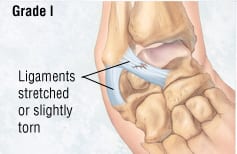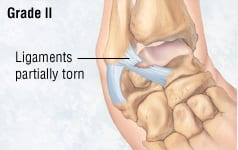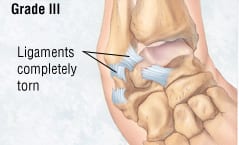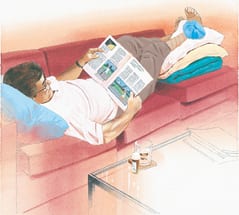Patient Basics: Ankle Sprain
Originally published by Harvard Health.
What Is It?
An ankle sprain is a stretch or tear in one or more of the ankle ligaments. Ankle ligaments are slightly elastic bands of tissue that keep the ankle bones in place. Ankles are particularly prone to sprain because of the small size of the joint and the forces exerted when walking, running and jumping, especially if the surface is uneven.
Depending on the severity of the injury, an ankle sprain is classified as:
- Grade I — The ankle is painful, but there is little ligament damage and little loss of function.
- Grade II — There is moderate ligament damage, and the ankle joint is somewhat loose.
- Grade III — One or more ligaments are torn, and the ankle joint is very loose or unstable.
Millions of ankle injuries occur each year in the United States. Most of them are sprains. Most sprains happen when the ankle twists suddenly. The most common injuries happen when the foot rolls onto the outside of the ankle, straining the outside ligaments of the ankle joint. These are called inversion injuries. Less common are eversion injuries, which happen when the ankle rolls onto the inside of the joint, stretching the ligaments on the inner side of the ankle.
Symptoms
Symptoms of a sprained ankle include:
- Ankle pain, tenderness and swelling
- Ankle bruising or discoloration
- Trouble moving the ankle
- Inability to put full weight on the ankle
Diagnosis
A health care professional may suspect that you have a sprained ankle based on the history of your injury and your current symptoms. To confirm the diagnosis, he or she will examine your ankle for:
- Swelling or deformity
- Inability to feel someone touching the skin
- Circulation
- Discoloration
- Instability
- Areas of tenderness
- Limitation in range of motion
- Inability to bear weight
For severe ankle injuries, a health care professional may request X-rays to determine whether a bone is broken. Fractures can occur with or without a sprain and can cause similar symptoms.
Expected Duration
How long it takes to heal depends on the severity of the sprain. Grade I sprains usually take one to two weeks to heal completely. Grade II sprains can take up to six weeks. Grade III sprains can take six months or longer to heal completely. On average, count on a two- to four-week healing period for any significant sprain.
Prevention
To reduce your risk of spraining an ankle:
- Pay close attention to the surface on which you are walking, running or jumping
- Do stretching exercises before and after any athletic activity
- Do balance exercises
- Wear well-fitting shoes that are appropriate for your sport
- Avoid sharp, sudden turns and changes in direction
- Strengthen foot and leg muscles by running, cycling or swimming
If you have had several ankle sprains, you’ll need a good rehabilitation program that involves strengthening and balance exercises. You may need to wear a brace to protect your ankle as you recover.
Treatment
The first treatment for an ankle sprain is usually RICE (rest, ice, compression and elevation):
- Rest the ankle and stop putting weight on it.
- Apply ice packs to the sprained ankle for 20- to 30-minute periods every 3 or 4 hours.
- Apply compression to the injury with an elastic wrap (but do not wrap so tightly that you block circulation and lose feeling in your toes).
- Elevate the injured ankle by propping up the leg.
For severe sprains, you may need a brace for protection and stability. You may need crutches until you can walk without pain. Nonsteroidal anti-inflammatory drugs (NSAIDs) can help to control pain and swelling. An orthopedist should evaluate people with Grade II or Grade III sprains. Grade III sprains with complete tears of the ligaments may require surgery to repair the injured ligaments.
In most cases, follow-up rehabilitative exercises are vital to restore strength and range of motion in the sprained ankle. These exercises should also help to prevent future ankle injuries.
When To Call a Professional
Get immediate medical attention if you are unable to put weight on the injured ankle or if the injured ankle appears to be obviously deformed. Also see your doctor if the pain and swelling continue or worsen.
Prognosis
The degree of recovery depends on the severity of the sprain and the age and health of the patient. Most people recover completely from sprains, especially Grade I and Grade II sprains. However, once a significant sprain occurs, the joint may never be as strong as it was before the injury. With appropriate rehabilitative exercises, some of this lost strength and stability may return.
Additional Info
National Institute of Arthritis and Musculoskeletal and Skin Diseases
Information Clearinghouse
National Insitutes of Health
1 AMS Circle
Bethesda, MD 20892-3675
Phone: 301-495-4484
Toll-Free: 1-877-226-4267
Fax: 301-718-6366
TTY: 301-565-2966
http://www.niams.nih.gov/
American Podiatric Medical Association (APMA)
9312 Old Georgetown Road
Bethesda, MD 20814
Phone: 301-571-9200
Toll-Free: 1-800-275-2762
Fax: 301-530-2752
http://www.apma.org/




